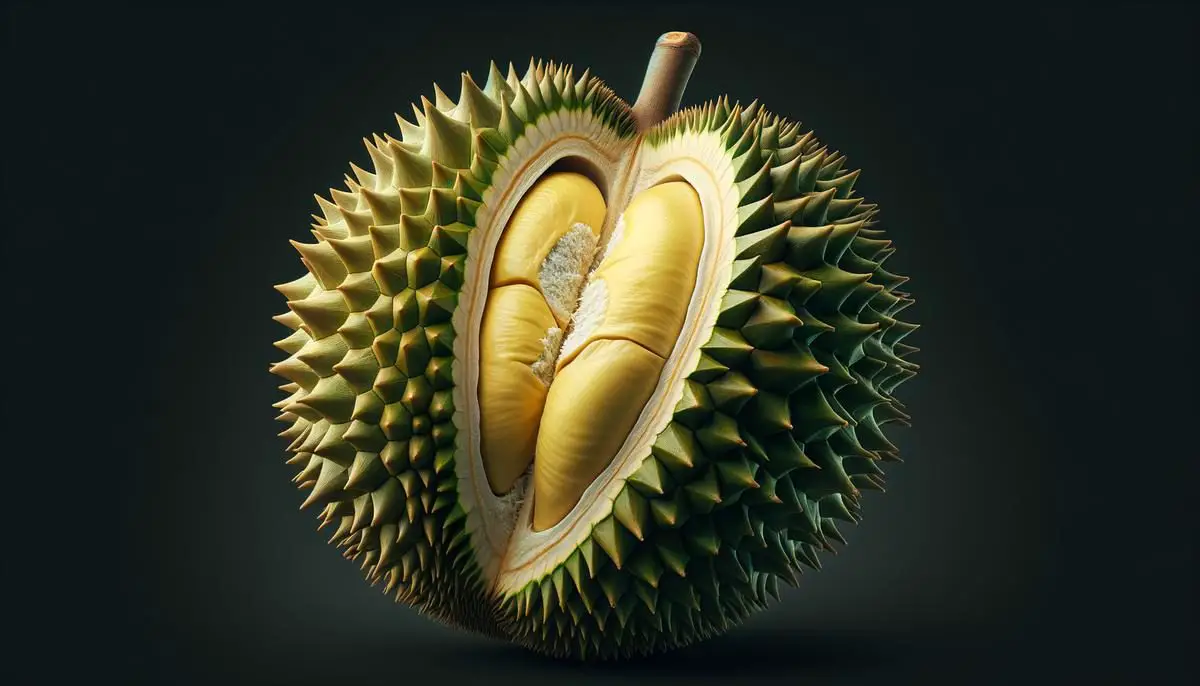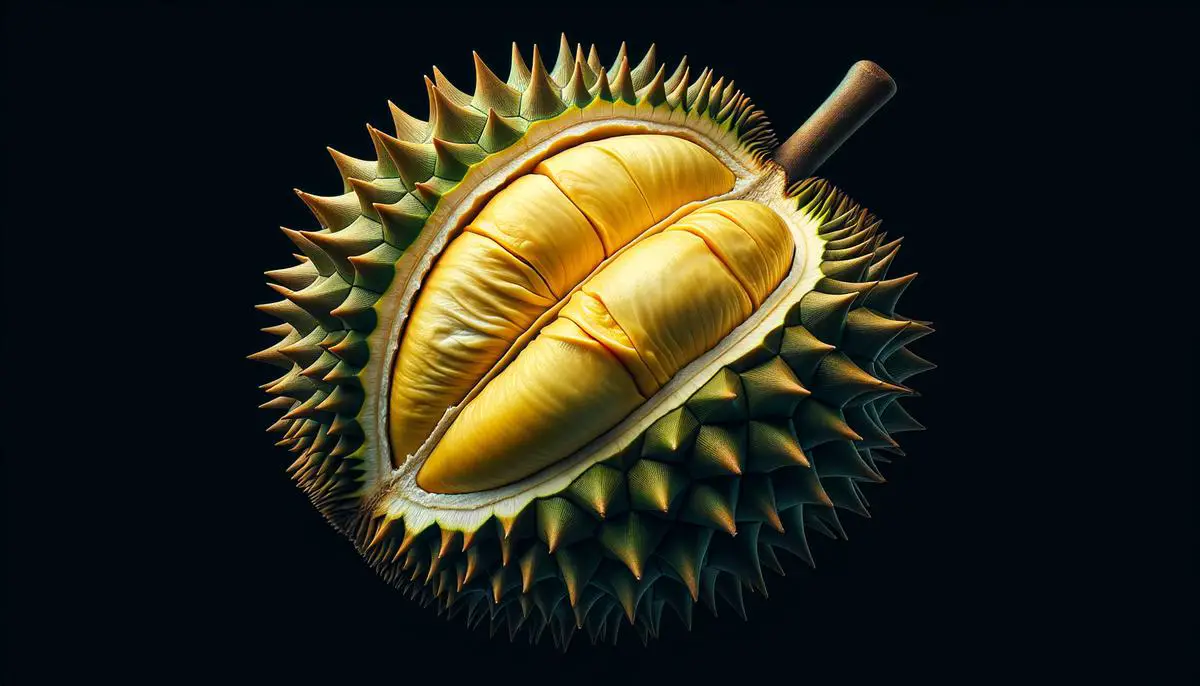
Durian Basics
Durian, often called the 'king of fruits', is an important fruit in Southeast Asian culture. Its thick, spiky shell might seem intimidating, but once opened, it reveals a soft, custard-like flesh. Despite its creamy texture, durian is well-known for its strong smell, often compared to ripe cheese and onions, making it a controversial food among many people.
Native to countries such as Malaysia, Thailand, and Indonesia, the durian tree grows well in tropical climates, thriving after the monsoon season. The fruit's name comes from 'duri', a Malay word meaning 'thorn', referring to its spiky outer shell. Inside the husk, sections of pulpy fruit contain large seeds. The difference between its tough exterior and the soft golden-yellow flesh inside is notable.
Durian is nutritious, containing vitamins, minerals, and dietary fiber. It provides important nutrients including vitamin C and potassium, offering benefits like better digestion and heart health1.
Durian has many culinary uses across Southeast Asia. It can be enjoyed fresh as well as used in cakes, ice creams, and traditional dishes that capture the essence of the region's cuisine.
However, durian's reputation is largely based on its strong scent, causing it to be banned from some public spaces. But this same characteristic attracts fans from around the world, eager to challenge their taste buds and try its unique flavor.
Understanding durian is about appreciating a part of Southeast Asia's cultural heritage, where it is valued and celebrated. This complex fruit represents the diversity of flavor and signifies both tradition and novelty. From its spiky shell to the creamy centre, every part of durian tells a story of nature's contrasts, giving it the title as the 'king of fruits'.

Taste and Smell
The Secret Behind Durian's Divisive Persona
Durian's taste and smell have both attracted and repelled people. The reason for such different reactions comes from durian's chemical composition—a distinct combination that produces love or disgust at first smell.
Central to durian's profile are volatile sulfur compounds, similar to those found in strong-smelling foods like garlic and onions, as well as certain cheeses. Durian combines these with esters, ketones, and alcohols, creating a unique aroma profile2. This combination might trigger culinary interest in some, while signaling others to avoid it.
Ethionine, an amino acid, plays a key role in durian's smell as it ripens. This compound confirms durian's ripeness, offering an enticing invitation to those ready for its creamy interior. Ethionine's presence also relates to durian's health benefits, including high levels of antioxidants.
Durian's flesh is complex, with hints of flavors compared to caramel, vanilla, and even cheesecake. This blend of flavors exists alongside its distinctive odors, creating the puzzle of durian's appeal.
Perception of durian's flavor and smell differs among people, partly due to genetic variations affecting smell receptors. Social and cultural factors also play important roles, with those raised in durian-loving communities more likely to enjoy the fruit.
The range of opinions on durian shows the subjectivity in human experience. Durian encourages a journey into unfamiliar culinary territory, offering a chance to explore tastes beyond the ordinary. Enjoying durian involves getting past its intimidating exterior, facing its smell, and developing an appreciation for the traditions and culinary delights it represents.
Durian's story is an invitation to understand the diversity of taste. Similar to developing a refined palate for wines or cheeses, appreciating durian is an adventurous step into a world where unique food experiences are the focus.

Health Benefits
The Nutritional Profile of Durian: Exploring its Range of Health Benefits
Looking beyond durian's tough exterior and strong smell reveals an interesting story – one where durian emerges not just as a treat for adventurous eaters, but as a source of health benefits. Let's explore the array of nutrients that makes durian a combination of taste challenge and nutritional powerhouse.
Durian's creamy flesh is rich in vitamins, especially vitamin C. This antioxidant strengthens the immune system and fights harmful free radicals3. The B-vitamin group – thiamine, riboflavin, niacin, and folate – supports energy production and cell health.
Within its custard-like pulp, durian contains valuable minerals. Potassium helps manage blood pressure and supports heart health. Magnesium contributes to muscle function, bone health, and sleep.
Dietary fiber, present in durian, supports digestion and helps manage blood sugar levels by slowing the absorption of sugar into the bloodstream4.
Durian also provides antioxidants such as polyphenols, anthocyanins, and flavonoids. These compounds neutralize free radicals, protecting cells from damage and potentially lowering the risk of some diseases.
Organosulfur compounds in durian have been associated with heart health, as they may help protect against inflammation and support cardiovascular well-being5.
Durian's story is one of contrast – intriguing scents guarding nutritional treasures, reminding us that the pursuit of health often follows unexpected paths. Enjoying durian is taking part in an exploration of life's diverse tastes while benefiting from its nutritional qualities. In its spiky cover lies not just a tale of strong flavor, but a story of wellness, full of valuable nutrients.

Culinary Uses
The Culinary Odyssey of Durian: From Traditional Tantalizations to Modern Gastronomic Marvels
Durian's Traditional Culinary Canvas
In the traditional culinary scenes of Southeast Asia, durian has long been a prominent ingredient, easily incorporated into various recipes. Its presence is notable in desserts like Durian Sticky Rice, where the creaminess of durian combines with slightly salty, sticky rice, creating a dish that has been enjoyed by generations.
Another time-honored creation is the Durian Pancake, where thin flour pancakes are filled with durian's creamy flesh, combining elements of the French crepe with a tropical twist. Each bite offers a unique combination of traditional and bold flavors.
A Modern Twist to Durian's Tale
As durian journeys through time into today's kitchens, it's being reimagined and represented in a variety of modern dishes. Creative chefs and adventurous home cooks incorporate its custardy pulp into ice creams that challenge the norms of frozen desserts, demonstrating that the combination of cold sensations and durian's unique flavor can create something novel.
In the savory realm, durian finds itself incorporated into curries, where its creamy texture complements spices and herbs, adding depth and complexity to sauces. This showcases durian's versatility – its ability to enhance both sweet and savory dishes with a unique flair.
In contemporary patisseries, chefs use durian to create pastries and desserts that pay homage to traditional roots while appealing to modern tastes. Durian Mousse Tarts feature airy mousse infused with durian's essence, resting delicately in crumbly tart shells—each serving as a subtle twist on culinary norms.
Indeed, these ventures into culinary arts highlight durian's paradoxical nature – off-putting to some, yet irresistibly appealing to others. Integrating durian into cooking involves a delicate balance, combining its bold character with the subtleties of complementary ingredients.
From traditional staples that have comforted many to modern interpretations that expand the boundaries of culinary innovation, durian remains a prominent ingredient—a testament to its enduring appeal. Its story in the world of cuisine continues, promising more chapters filled with creative dishes, each showcasing durian's unique qualities.

Buying and Storage
Navigating the Thorny Quest for The Perfect Durian: A Chronicle of Selection, Acquisition, and Conservation
Selecting Your Durian: The Gauntlet of Choice
The art of choosing a worthy durian begins not with the eyes, but with the nose. Engage your sense of smell; a durian with a strong, distinctive aroma without being overly pungent is a sign of ripeness.
Inspect its husk—a green exterior that yields slightly under gentle pressure suggests a ripe fruit within. Look for any cracks; they may reveal the creaminess inside. However, be cautious: oversized cracks or an overly dry stem indicate a fruit past its prime.
Acquisition: Where Myth Meets Reality
Durian can be found in various places, such as:
- Asian markets filled with exotic produce
- Online retailers specializing in tropical fruits
Interacting with local vendors knowledgeable about the fruit can provide valuable insights for consumers.
When shopping online, exercise caution. Seek reputable sources with positive reviews and testimonials to ensure a quality durian arrives at your doorstep.
The Sanctuary of Preservation: Storing Your Durian
After bringing your durian home, consider where it will be stored until it's ready to be enjoyed. An unopened durian prefers cooler environments to slow down ripening: a countertop may suffice for one to two days, wrapping it in newspaper to contain its scent.
If you plan to save the durian for later, you can store it in the freezer, which can preserve its quality for months.1 When you're ready to eat it, allow the durian time to thaw—this will restore its creamy texture and taste.
Armed with knowledge on selecting, acquiring, and storing your durian, you're ready to explore its unique flavors. This intriguing fruit, with its thorny exterior, awaits your discovery, offering a memorable culinary experience.

The essence of durian goes beyond its distinct aroma and imposing appearance, representing a tapestry of cultural significance, culinary diversity, and health benefits. Durian serves as a bridge between tradition and innovation, inviting us to look past initial impressions and discover the range of flavors and stories it encompasses.
As we reflect on this exploration of the multifaceted world of durian, let us recognize that it is not merely a fruit but a symbol of nature's intricacy and the culinary heritage of Southeast Asia. Durian's appeal lies in its ability to engage the senses, inspire conversations, and create enduring memories. It exemplifies the power of food to unite people, evoke emotions, and celebrate the diversity of our world.
So, the next time you encounter this thorny fruit, approach it with an open mind and a willingness to explore. Embrace the experience, savor the flavors, and allow yourself to be captivated by the allure of durian. In doing so, you not only engage in a unique culinary journey but also pay tribute to the rich cultural tapestry that has shaped this beloved fruit.



